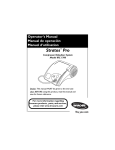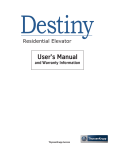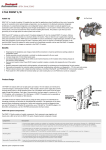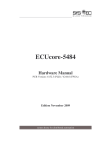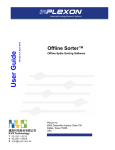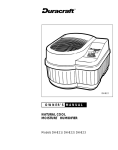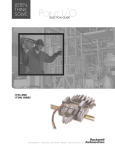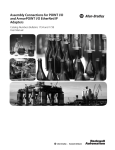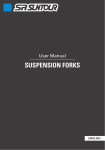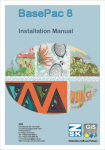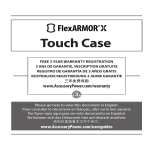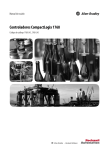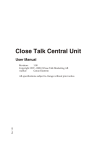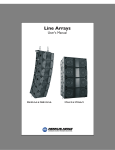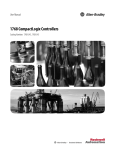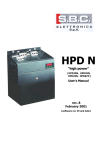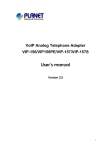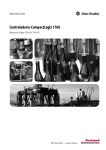Download 1798-UM001B-EN-P, FlexArmor User Manual
Transcript
FlexArmor 1798-ADN (Contains information on 1798-IB4, -IB8, -OB4E, -OB8E, -IB4D, -IE4, -OE2) User Manual Important User Information Because of the variety of uses for the products described in this publication, those responsible for the application and use of these products must satisfy themselves that all necessary steps have been taken to assure that each application and use meets all performance and safety requirements, including any applicable laws, regulations, codes and standards. In no event will Rockwell Automation be responsible or liable for indirect or consequential damage resulting from the use or application of these products. Any illustrations, charts, sample programs, and layout examples shown in this publication are intended solely for purposes of example. Since there are many variables and requirements associated with any particular installation, Rockwell Automation does not assume responsibility or liability (to include intellectual property liability) for actual use based upon the examples shown in this publication. Allen-Bradley publication SGI-1.1, Safety Guidelines for the Application, Installation and Maintenance of Solid-State Control (available from your local Rockwell Automation office), describes some important differences between solid-state equipment and electromechanical devices that should be taken into consideration when applying products such as those described in this publication. Reproduction of the contents of this copyrighted publication, in whole or part, without written permission of Rockwell Automation, is prohibited. Throughout this publication, notes may be used to make you aware of safety considerations. The following annotations and their accompanying statements help you to identify a potential hazard, avoid a potential hazard, and recognize the consequences of a potential hazard: WARNING ! ATTENTION ! IMPORTANT Identifies information about practices or circumstances that can cause an explosion in a hazardous environment, which may lead to personal injury or death, property damage, or economic loss. Identifies information about practices or circumstances that can lead to personal injury or death, property damage, or economic loss. Identifies information that is critical for successful application and understanding of the product. FlexArmor and RSNetWorx for DeviceNet are trademarks of Rockwell Automation. MicroSoft Windows is a registered trademark of Microsoft Corporation. Summary of Changes New Modules Information In this version of the FlexArmor™ User Manual information was added about the following three FlexArmor modules: • 1798-IB4D, • 1798-IE4, and • 1798-OE2. Communication and mapping information about these modules are contained in chapter 2. Configuration information is found in chapter 3. 1 Publication 1798-UM001B-EN-P - November 2002 Summary of Changes 2 Notes: Publication 1798-UM001B-EN-P - November 2002 Preface Introduction Use this manual to install, communicate with, map, configure, and troubleshoot the FlexArmor system. Contents You will find the following information in this manual: For information about installing your DeviceNet adapter module how communication takes place and I/O image mapping how to configure your DeviceNet adapter troubleshooting module specifications See Chapter 1 Chapter 2 Chapter 3 Chapter 4 Appendix A Audience This manual is intended for engineers and technicians who are installing, programming, and maintaining a FlexArmor system. What We assume We assume you: • know each of your device’s I/O parameters and requirements • are familiar with RSNetWorx for DeviceNet™ • are familiar with the Microsoft® Windows® environment Common Techniques Used in This Manual 1 The following conventions are used throughout this manual: • Bulleted lists provide information, not procedural steps. • Numbered lists provide sequential steps. • Pictures of keys and/or screens represent the actual keys you press or the screens you use. • Actions you must perform appear in bold text. For example: Click View to display the EDS file. Publication 1798-UM001B-EN-P - November 2002 Preface 2 Rockwell Automation Support Before you contact Rockwell Automation for technical assistance, we suggest you please review the troubleshooting information contained in chapter 4 of this publication first. If the problem persists, call your local distributor or contact Rockwell Automation in one of the following ways: Phone Internet United States/Canada 1.440.646.5800 Outside United States/Canada You can access the phone number for your country via the Internet: 1. Go to http://www.ab.com 2. Click on Product Support (http://support.automation.rockwell.com) 3. Under Support Centers, click on Contact Information ⇒ 1. Go to http://www.ab.com 2. Click on Product Support (http://support.automation.rockwell.com) Your Questions or Comments on this Manual If you find a problem with this manual, please notify us of it on the enclosed How Are We Doing form found in the back of the manual. Publication 1798-UM001B-EN-P - November 2002 Table of ContentsTable of Contents Chapter 1 Install Your DeviceNet Adapter Module Chapter Objectives . . . . . . . . . . . . . . . . . . . . . . . . . . . . . . About the FlexArmor System . . . . . . . . . . . . . . . . . . . . . . . DeviceNet Adapter Components . . . . . . . . . . . . . . . . . . . . Diagnostic Indicators . . . . . . . . . . . . . . . . . . . . . . . . . . Power Requirements . . . . . . . . . . . . . . . . . . . . . . . . . . . . . Mount the FlexArmor Platform. . . . . . . . . . . . . . . . . . . . . . Mounting Instructions . . . . . . . . . . . . . . . . . . . . . . . . . Set the Network Address Switch on the DeviceNet Adapter. Install Your FlexArmor DeviceNet Adapter Module. . . . . . . Connect External Wiring . . . . . . . . . . . . . . . . . . . . . . . . . . 1-1 1-1 1-2 1-2 1-2 1-3 1-3 1-4 1-4 1-5 Chapter 2 How Communication Takes Place Chapter Objectives . . . . . . . . . . . . . . . . . . . . . . . . . . . . . . 2-1 Communication Over the FlexArmor Backplane . . . . . . . . . 2-1 and I/O Image Table Mapping About I/O Structure. . . . . . . . . . . . . . . . . . . . . . . . . Description of Adapter Input Status Word . . . . . . Communication Choices . . . . . . . . . . . . . . . . . . . . . Mapping Data into the Image Table . . . . . . . . . . . . . Description of 1798-IB4 Image Table Mapping . . Description of 1798-IB4D Image Table Mapping . Description of 1798-IB8 Image Table Mapping . . Description of 1798-OB4E Image Table Mapping Description of 1798-OB8E Image Table Mapping Description of 1798-IE4 Image Table Mapping . . Description of 1798-OE2 Image Table Mapping. . . . . . . . . . . . . . . . . . . . . . . . . . . . . . . . . . . . . . . . . . . . . . . . . . . . . . . . . 2-2 2-3 2-4 2-5 2-5 2-6 2-7 2-8 2-9 2-9 2-12 Chapter 3 Configure Your DeviceNet Adapter Chapter Objectives . . . . . . . . . . . . . . . . . . . . . . . . . . . . . . 3-1 Configure Your Adapter’s FlexArmor System . . . . . . About RSNetWorx for DeviceNet . . . . . . . . . . . . . . . . . Configure Your FlexArmor Adapter and System Online Configure the Adapter . . . . . . . . . . . . . . . . . . . . . . Configure the Module . . . . . . . . . . . . . . . . . . . . . . View Adapter Parameters . . . . . . . . . . . . . . . . . . . . Special Parameters . . . . . . . . . . . . . . . . . . . . . . . . . View I/O Summary . . . . . . . . . . . . . . . . . . . . . . . . Map the Scanner . . . . . . . . . . . . . . . . . . . . . . . . . . . . . . . . . . . . . . . . . . . . . . . . . . . . . . . . 3-1 3-2 3-3 3-4 3-6 3-7 3-13 3-15 3-18 Chapter 4 Troubleshooting i Chapter Objectives . . . . . . . . . . . . . . . . . . . . . . . . . . . . . . 4-1 Troubleshoot With the Indicators. . . . . . . . . . . . . . . . . . . . 4-1 Publication 1798-UM001B-EN-P - November 2002 Table of ContentsTable of Contents ii Appendix A Specifications Publication 1798-UM001B-EN-P - November 2002 Input Module Specifications. . . . . . . . . . . . . Specifications for the 1798-IB4 Module . . Specifications for the 1798-IB8 Module . . Specifications for the 1798-IB4D Module. Specifications for the 1798-IE4 Module . . Output Module Specifications . . . . . . . . . . . Specifications for the 1798-OB4E Module Specifications for the 1798-OB8E Module Specifications for the 1798-OE2 Module . Communication Adapter Specifications. . . . . Field Termination Plug Specifications. . . . . . Baseplate Specifications. . . . . . . . . . . . . . . . . . . . . . . . . . . . . . . . . . . . . . . . . . . . . . . . . . . . . . . . . . . . . . . . . . . . . . . . . . . . . . . . . . . . . . . . . . . . . . . . . . . . . . . . . . . . . . . . . . . . . . . . . . . . . . . . . . . . . . . . . . . . . . . . . A-1 A-1 A-2 A-3 A-5 A-7 A-7 A-8 A-9 A-12 A-13 A-14 Chapter 1 Install Your DeviceNet Adapter Module Chapter Objectives This chapter describes the FlexArmor system, the DeviceNet Adapter and the procedures for installing your DeviceNet adapter module. The sections in this chapter include: • • • • • • • About the FlexArmor System the FlexArmor system adapter components power requirements mount the adapter set the adapter address switches install the adapter module connect the external wiring FlexArmor is a small, modular block I/O system for distributed applications that performs all of the functions of rack-based I/O. The FlexArmor system contains the following components: • Baseplate, 1798-BP2, -BP4, -BP6, or -BP8 • DeviceNet adapter/power supply, 1798-ADN - powers the internal logic for as many as eight I/O modules • I/O modules contain the bus interface and circuitry needed to perform specific functions related to your application. These I/O modules include: – Input modules, 1798-IB4 or -IB8, -IB4D, and -IE4 – Output modules, 1798-OB4E or -OB8E, and OE2 • Field Termination Plug (FTP), 1798-DFTP1 or -DFTP2 • Filler module, 1798-N2 1 Publication 1798-UM001B-EN-P - November 2002 1-2 Install Your DeviceNet Adapter Module 1798-ADN FTP (Field Termination Plug) 1798-N2 1798-0B4E 42537 1798-BP4 4-position Baseplate For information on how communications occurs on the FlexArmor system backplane, refer to Chapter 2. DeviceNet Adapter Components The adapter module consists of the following major components: • diagnostic indicators • node address switch Diagnostic Indicators Diagnostic indicators are located on the front panel of the adapter module. They show both normal operation and error conditions in your remote I/O system. The indicators are: • Mod/Net status • I/O status A complete description of the diagnostic indicators and how to use them for troubleshooting is explained in Chapter 4. Power Requirements Publication 1798-UM001B-EN-P - November 2002 The FlexArmor system requires a current of 400 mA at 24V dc from the 1798-FTP sensor power connector for FLEX bus operation. This is sufficient to support up to 8 modules. Remember to add this amount to current requirements for other modules using the same 24V supply. The FlexArmor system consumed 90 mA of DeviceNet power. Install Your DeviceNet Adapter Module Mount the FlexArmor Platform 1-3 The DeviceNet adapter module can be mounted directly on a machine. Refer to the specific method of mounting below. Mounting Instructions To mount the platform on a wall or panel, use the screw holes provided in the FlexArmor Baseplate. Install the mounting Baseplate as follows: 1. Lay out the required points as shown in the drilling dimension drawing. 25 mm (0.98 in.) clearance all around 102.5 mm 4.0 in. 102.5 mm 4.0 in. 102.5 mm 4.0 in. 102.5 mm 4.0 in. 92 mm 3.6 in. 69 mm 2.7 in. 42665 2. Drill the necessary holes for #10 (M6) machine or self-tapping screws. 3. Mount the Baseplate using #10 (M6) screws. 4. Connect functional ground to ground using the functional ground lug connector. To view a drill template for the FlexArmor Baseplate, refer to the website http://www.ab.com/abecad/. You are now ready to set the node address on the FlexArmor adapter module and to install your selected FlexArmor components. Please refer to the individual component installation instructions for guidelines. Publication 1798-UM001B-EN-P - November 2002 1-4 Install Your DeviceNet Adapter Module Set the Network Address Switch on the DeviceNet Adapter Valid node addresses are 00 to 63. Set the network address using the rotary switches. The setting of the network address cannot be changed using the DeviceNet configuration software. Each module is shipped set for node address 63. The switches are located on the underside of the module. The two switches are: • MSD (most significant digit) • LSD (least significant digit) To reset the node address, use a small blade screwdriver to rotate the switches. Line up the small black dot on the switch with the number setting you wish to use. MSD Switches are shown in the 63 position. IMPORTANT Install Your FlexArmor DeviceNet Adapter Module LSD 43387 The baud rate for the adapter is set by way of “baud detection” (Autobaud) at power up. To install the FlexArmor DeviceNet Adapter Module: 1. Hold the adapter at an angle and engage the top of the adapter in the indention on the rear of the Baseplate. IMPORTANT The adapter module must be installed only in the adapter slot, next to the FTP. 2. Press the module down flush with the panel until the locking lever locks. Publication 1798-UM001B-EN-P - November 2002 Install Your DeviceNet Adapter Module 1-5 3. Repeat steps 1 and 2 for each I/O module for the remaining Baseplate I/O slots. IMPORTANT I/O modules can be installed in any slot location to the right of the adapter module. The adapter is capable of addressing eight modules. 4. Screw down the module retaining screws to ensure IP67 compliance. IMPORTANT Connect External Wiring • Torque the screws to 0.5-0.7 Nm. (4.43-6.2 inch pounds). • Dust caps on the I/O modules must have 4 inch pounds of torque to maintain IP67 compliance. Connect external wiring to the DeviceNet Field Termination Plug (DFTP) as shown below. 1. Connect the DeviceNet cable to the DFTP as shown. Connect Connector Pin To BLK Wire 3 -V BLU Wire 5 CAN* Low Base Wire 1 Drain WHT Wire 4 CAN High RED Wire 2 +V *CAN=Controller Area Network Micro Male connector (In) 3 4 5 2 3 Micro Female connector (Daisy Chain Out) 1 5 2 3 5 4 1 4 Mini Male connector (In) 1 2 42538 DFTP1 4 5 3 2 Mini Female connector (Daisy Chain Out) 1 42653 DFTP2 2. Insert the connector into the mating connector on the 3. DeviceNet FTP module. Publication 1798-UM001B-EN-P - November 2002 1-6 Install Your DeviceNet Adapter Module 4. Connect 24V dc power to sensor voltage for adapter and input module power. 5. Connect 24V dc power to output voltage for output module power. Pin Function 1 Output Power + 2 Sensor Power + 3 Sensor Power - 4 Output Power - 3 1 4 2 Male Connector 42539 Publication 1798-UM001B-EN-P - November 2002 Chapter 2 How Communication Takes Place and I/O Image Table Mapping Chapter Objectives In this chapter, you will learn about: • communication over the FlexArmor backplane (between the DeviceNet adapter and the I/O modules) • how data is mapped into the I/O image table Communication Over the FlexArmor Backplane One 1798-ADN DeviceNet adapter can interface with up to eight FlexArmor I/O modules placed in a FlexArmor baseplate. The adapter communicates to other network system components (typically one or more controllers or scanners, and/or programming terminals) over the DeviceNet network. The adapter communicates with its I/O modules over the backplane. I/O Module I/O Module Inputs Read Network DeviceNet Adapter Write Status Read Words Outputs Configuration Slot 0 Write Words I/O Module Inputs Inputs Status Status Outputs Outputs Configuration Configuration Slot 1 Slot 7 The I/O map for a module is divided into read words and write words. Read words consist of input and status words and write words consist of output and configuration words. The number of read words or write words can be zero or more. The length of each I/O module’s read words and write words varies in size depending on module complexity. Each I/O module will support at least 1 input word or 1 output word. Status and configuration are optional, depending on the module. 1 Publication 1798-UM001B-EN-P - November 2002 2-2 How Communication Takes Place and I/O Image Table Mapping For example, a 4 point discrete input module will have up to 2 read words and 1 write word. Module Image I/O Image Input Size Inputs 1 or 2 Words Not used 4-point Discrete Input Module Output Size Not used 0 or 1 Words Delay Time Delay Time Check the I/O map for each module for the exact mapping. About I/O Structure Output data is received by the adapter in the order of the installed I/O modules. The Output data for slot 0 is received first, followed by the Output data for slot 1, and so on up to slot 7. The first word of input data sent by the adapter is the Adapter Status Word. This is followed by the input data from each slot, in the order of the installed I/O modules. The Input data from slot 0 is first after the status word, following by Input data from slot 2, and so on up to slot 7. DeviceNet Adapter Read Data Adapter Status Slot 0 Input Data Slot 1 Input Data ... ... Network READ Slot 7 Input Data Read Slot 0 Output Data Slot 1 Output Data ... ... Network WRITE Slot 7 Output Data Publication 1798-UM001B-EN-P - November 2002 Write I/O Module I/O Module Slot 0 Slot 1 ... I/O Module Slot 7 How Communication Takes Place and I/O Image Table Mapping 2-3 Description of Adapter Input Status Word The input status word consists of: • I/O module fault bits - 1 status bit for each slot • node address changed - 1 bit Not Used 8 7 6 5 4 3 2 1 0 Slot 2 Slot 1 Slot 0 9 through 15 Slot 4 Slot 3 Bit: 15 Slot 7 Slot 6 Slot 5 I/O Module Fault Bits 42843 Node Address Changed Bit The adapter input status word bit descriptions are shown in the following table. Bit Description I/O Module Fault Node Address Changed Bit Explanation 0 This bit is set (1) when an error is detected in slot position 0. 1 This bit is set (1) when an error is detected in slot position 1. 2 This bit is set (1) when an error is detected in slot position 2. 3 This bit is set (1) when an error is detected in slot position 3. 4 This bit is set (1) when an error is detected in slot position 4. 5 This bit is set (1) when an error is detected in slot position 5. 6 This bit is set (1) when an error is detected in slot position 6. 7 This bit is set (1) when an error is detected in slot position 7. 8 This bit is set (1) when the node address switch setting has been changed since power up. 9 thru 15 Not used - sent as zeroes. Publication 1798-UM001B-EN-P - November 2002 2-4 How Communication Takes Place and I/O Image Table Mapping Possible causes for an I/O Module Fault are: • • • • • Communication Choices transmission errors on the FlexArmor backplane a failed module a module removed from the FlexArmor Baseplate incorrect module inserted in a slot position the slot is empty, but the platform is configured for a module in the slot location The FlexArmor DeviceNet adapter module supports multiple communication choices. These choices all use the default I/O structure previously described. The adapter master makes the actual communication choice. The choices are: Polled - data is sent by the adapter in response to received data Strobe - data is sent by the adapter in response to the strobe command. The single bit allocated to the adapter in the strobe message is not used. If the configured size of the input data (sent from the adapter) is greater than 8 bytes, the strobe connection establishment will fail. In this case, the input size must be re-configured to 8 bytes or less. Change of State - data is sent by the adapter based on detection of any changed value within the input data. Data is independently received based on change of state from the sender. Data in both directions can be acknowledged or unacknowledged depending on the run time configuration of the system. Cyclic - data is sent cyclically by the adapter based on a configured time value. Data is independently received cyclically from the sender. Data in both directions can be acknowledged or unacknowledged depending on the run time configuration of the system. Publication 1798-UM001B-EN-P - November 2002 How Communication Takes Place and I/O Image Table Mapping Mapping Data into the Image Table 2-5 All FlexArmor modules are supported by the DeviceNet adapter. At present, these consist of: Module Description Catalog Number For image table mapping refer to: 4 Sinking Input Module 1798-IB4 2-5 4 Sinking Input Diagnostic Module 1798-IB4D 2-6 8 Sinking Input Module 1798-IB8 2-7 4 Electronically Fused Sourcing Output Module 1798-OB4E 2-8 8 Electronically Fused Sourcing Output Module 1798-OB8E 2-9 4 Analog Input Module 1798-IE4 2-9 2 Analog Output Module 1798-OE2 2-12 Description of 1798-IB4 Image Table Mapping I/O Image Input Size Read Module Image Inputs Reserved 1 or 2 Words Not used Fault Input Output Size 0 or 1 Word Write Fault Enabled Reserved Reserved Delay Time 42840 Memory Map of 4 Point Discrete Input Module Image Table - 1798-IB4 Decimal Bit 15 Octal Bit 17 14 13 12 11 10 09 08 07 06 05 04 03 02 01 00 Size 16 15 14 13 12 11 10 07 06 05 Not used Not used Reserved FE Reserved 04 03 02 01 00 D3 D2 D1 D0 Read Word 1 FO Read Word 2 DT 00-3 Write Word 1 Where D = Input Data (D0 corresponds to input 0, D1 corresponds to input 1, etc.), DT = Input Delay Time (DT 00-3 corresponds to inputs 0 through 3), FO = Fault Bit - Indicates status of module sensor power (0=Normal, 1=Sensor Power Shorted), FE = Fault Enabled Bit, must be set to return fault bit (FO) from module. The “Fault Enabled” bit will be set automatically if the input filter times are configured through RSNetWorx for DeviceNet. Publication 1798-UM001B-EN-P - November 2002 2-6 How Communication Takes Place and I/O Image Table Mapping Input Delay Times for the 1798-IB4 Input Module Bits Description Selected Delay Time 02 01 00 Delay Time for Inputs 00-03 0 0 0 Delay Time 0 (default) 256µs 0 0 1 Delay Time 1 512µs 0 1 0 Delay Time 2 1ms 0 1 1 Delay Time 3 2ms 1 0 0 Delay Time 4 4ms 1 0 1 Delay Time 5 8ms 1 1 0 Delay Time 6 16ms 1 1 1 Delay Time 7 32ms Description of 1798-IB4D Image Table Mapping I/O Image Input Size Read Module Image Short Circuit Detect 1 or 2 Words Open Wire Detect Inputs Not Used Not used Output Size 0 or 1 Word Write Reserved Open Wire Disables Delay Time Reserved 43388 Memory Map of 4 Point Discrete Input Module Image Table - 1798-IB4D Decimal Bit 15 Octal Bit 17 14 13 12 11 10 09 08 07 06 05 04 03 02 01 00 Size S3 16 15 14 13 12 11 10 S2 S1 S0 W3 W2 W1 W0 07 06 05 04 Not Used 03 02 01 00 Dec I3 I2 I1 I0 Read Word 1 Not Used Reserved D3 D2 D1 D0 Read Word 2 Reserved DT 00-3 Write Word 1 Where I = Input Data (I0 corresponds to input 0, I1 corresponds to input 1, etc.); DT = Input Delay Time (DT 00-3 corresponds to inputs 0 through 3) W = Open Wire Detect; S = Short Circuit Detect; D = Open Wire Disable Publication 1798-UM001B-EN-P - November 2002 How Communication Takes Place and I/O Image Table Mapping 2-7 Input Delay Times for the 1798-IB4D Input Module Bits Description Selected Delay Time 02 01 00 Delay Time for Inputs 00-03 0 0 0 Delay Time 0 (default) 256µs 0 0 1 Delay Time 1 512µs 0 1 0 Delay Time 2 1ms 0 1 1 Delay Time 3 2ms 1 0 0 Delay Time 4 4ms 1 0 1 Delay Time 5 8ms 1 1 0 Delay Time 6 16ms 1 1 1 Delay Time 7 32ms Description of 1798-IB8 Image Table Mapping I/O Image Input Size Read Module Image Reserved 1 or 2 Words Inputs Not used Fault Input Output Size 0 or 1 Word Write Fault Enabled Reserved Reserved Delay Time 42840 Memory Map of 8 Point Discrete Input Module Image Table - 1798-IB8 Decimal Bit 15 Octal Bit 17 14 13 12 11 10 09 08 07 06 05 04 03 02 01 00 Size 16 15 14 13 12 11 Not used 10 07 06 05 04 03 02 01 D7 D6 D5 D4 D3 D2 D1 D0 Read Word 1 Not used Reserved FE Reserved 00 FO Read Word 2 DT 00-07 Write Word 1 Where D = Input Data (D0 corresponds to input 0, D1 corresponds to input 1, etc.), DT = Input Delay Time (DT 00-07 corresponds to inputs 0 through 7) FO = Fault Bit - Indicates status of module sensor power (0=Normal, 1=Sensor Power Shorted), FE = Fault Enabled Bit, must be set to return fault bit (FO) from module. The “Fault Enabled” bit will be set automatically if the input filter times are configured through RSNetWorx for DeviceNet. Publication 1798-UM001B-EN-P - November 2002 2-8 How Communication Takes Place and I/O Image Table Mapping Input Delay Times for the 1798-IB8 Input Module Bits Description Selected Delay Time 02 01 00 Delay Time for Inputs 00-07 0 0 0 Delay Time 0 (default) 256µs 0 0 1 Delay Time 1 512µs 0 1 0 Delay Time 2 1ms 0 1 1 Delay Time 3 2ms 1 0 0 Delay Time 4 4ms 1 0 1 Delay Time 5 8ms 1 1 0 Delay Time 6 16ms 1 1 1 Delay Time 7 32ms Description of 1798-OB4E Image Table Mapping I/O Image Input Size Module Image 0 or 1 Word Read Not Used Fault Bits Reserved Outputs Output Write 1 Word 42824 Memory Map of 4 Point Discrete Output Module Image Table - 1798-OB4E Decimal Bit 15 Octal Bit 17 14 13 12 11 10 09 08 07 06 05 04 03 02 01 00 Size 16 15 14 13 12 11 10 07 06 05 04 03 02 01 00 Not used F3 F2 F1 F0 Reserved O3 O2 O1 O0 Write Word 1 Where O = Output Value (O0 corresponds to output 0, O1 corresponds to output 1, etc.) F0-F3 = Indicate the status of each output point (0=Output normal, 1=Output faulted) Publication 1798-UM001B-EN-P - November 2002 Read Word 1 How Communication Takes Place and I/O Image Table Mapping 2-9 Description of 1798-OB8E Image Table Mapping I/O Image Input Size Module Image 0 or 1 Word Read Not Used Fault Bits Reserved Outputs Output Write 1 Word 42824 Memory Map of 8 Point Discrete Output Module Image Table - 1798-OB8E Decimal Bit 15 Octal Bit 17 14 13 12 11 10 09 08 07 06 05 04 03 02 01 00 Size 16 15 14 13 12 11 10 07 06 05 04 03 02 01 00 Not used F7 F6 F5 F4 F3 F2 F1 F0 Reserved O7 O6 O5 O4 O3 O2 O1 O0 Write Word 1 Read Word 1 Where O = Output Value (O0 corresponds to output 0, O1 corresponds to output 1, etc.) F0-F7 = Indicate the status of each output point (0=Output normal, 1=Output faulted) Description of 1798-IE4 Image Table Mapping I/O Image Module Image Input Size Input Data Channel 0 1 to 9 Words Input Data Channel 1 Input Data Channel 2 Input Data Channel 3 Not Used Not Used Not Used Not Used PU Underrange Configure Select Output Size Not Used 0 to 1 Word Not Used Not Used Not Used Not Used Publication 1798-UM001B-EN-P - November 2002 2-10 How Communication Takes Place and I/O Image Table Mapping Memory Map of Analog Input Module Image Table - 1798-IE4 Decimal 15 Bit 14 Octal Bit 17 16 13 12 11 10 09 08 07 06 05 04 03 02 01 00 Size 15 14 13 12 11 10 07 06 05 04 03 02 01 00 S Analog Value Channel 0 Read Word 1 S Analog Value Channel 1 Read Word 2 S Analog Value Channel 2 Read Word 3 S Analog Value Channel 3 Read Word 4 S Not Used Read Word 5 S Not Used Read Word 6 S Not Used Read Word 7 S Not Used Read Word 8 PU Not Used - Set to 0 Not Used - Set to Zero C3 C2 C1 C0 Not Used - Set to 0 U3 U2 U1 U0 Read Word 9 F3 F2 F1 F0 Write Word 1 Not Used - Set to 0 Write Word 2 thru 6 Where PU = Power up bit; U = Underrange bits for 4-20mA inputs; C = Configure select bit; F = Full range bit; S = Sign bit (in 2’s complement) Range Selection Bits for the 1798-IE4 Channel No. Channel 0 Channel 1 Channel 2 Channel 3 F0 C0 F1 C1 F2 C2 F3 C3 Decimal Bit 00 08 01 09 02 10 03 11 0-10V dc/0-20mA 1 0 1 0 1 0 1 0 4-20mA 0 1 0 1 0 1 0 1 10 to +10V dc 1 1 1 1 1 1 1 1 Off1 0 0 0 0 0 0 0 0 C = Configure select bit; F = Full range bit 1. When configured to off, individual channels will return 0000H. Publication 1798-UM001B-EN-P - November 2002 How Communication Takes Place and I/O Image Table Mapping 2-11 Word/Bit Descriptions for the 1798-IE4 Analog Input Module Write Word Decimal Bit Definition Bits 00-14 Channel 0 analog data - 12-bit left justified two’s complement number; unused lower bits are zero; 4-20mA uses all 16 bits Bit15 Channel 0 analog data sign bit Bits 00-14 Channel 1 analog data - 12-bit left justified two’s complement number; unused lower bits are zero; 4-20mA uses all 16 bits Bit15 Channel 1 analog data sign bit Bits 00-14 Channel 2 analog data - 12-bit left justified two’s complement number; unused lower bits are zero; 4-20mA uses all 16 bits Bit15 Channel 2 analog data sign bit Bits 00-14 Channel 3 analog data - 12-bit left justified two’s complement number; unused lower bits are zero; 4-20mA uses all 16 bits Bit15 Channel 3 analog data sign bit Read Word 1 Read Word 2 Read Word 3 Read Word 4 Read Word 5-8 Read Word 9 Not Used Bits 00-03 Underrange bits (U) for individual channels (4-20mA current input only) - Bit 00 corresponds to input channel 0, bit 01 corresponds to input channel 1, and so on. When set (1), indicates either a broken or open input wire, or input current below 4-20mA. Bits 04-14 Not used - set to 0 Bit 15 Power Up bit - This bit is set to 1 when all bits in the configuration register are 0 (unconfigured state). The configuration register can be cleared by either of the reset inputs, or by the user writing all zeroes to it. Bits 00-03 Full range bits (F) for individual channels - Bit 00 corresponds to input channel 0, bit 01 corresponds to input channel 1, and so on. Refer to range selection above. Bits 08-11 Configure select bits (C) for individual channels - Bits 08 corresponds to input channel 0, bit 09 corresponds to input 1, and so on. Refer to range selection above. Bits 00-15 Not used - set to 0 Write Word 1 Write Word 2-6 Publication 1798-UM001B-EN-P - November 2002 2-12 How Communication Takes Place and I/O Image Table Mapping Description of 1798-OE2 Image Table Mapping I/O Image Input Size 0 to 1 Words PU Not Used Diagnostics Analog Output Data 0 Output Size Analog Output Data 1 1 to 6 Words Not Used Not Used Not Used OE Not Used Config. Select Not Used Full Range Not Used Not Used Not Used Not Used Not Used Memory Map of Analog Output Module Image Table - 1798-OE2 Decimal 15 Bit 14 13 Octal Bit 17 16 15 12 11 10 09 08 07 06 05 04 03 02 01 00 Size 14 13 12 PU 11 10 07 06 05 04 03 Not Used - Set to Zero 02 01 00 W1 W0 Read Word 1 S Analog Value Channel 0 Write Word 1 S Analog Value Channel 1 Write Word 2 S Not Used Write Word 3 S Not Used Write Word 4 S S Not Used - Set to 0 Not Used - Set to 0 S C1 C0 OE1 OE0 Write Word 5 Not Used - Set to 0 Not Used - Set to 0 F1 F0 Write Word 6 Write Word 7 thru 14 Where PU = Power up bit; W = Diagnostic bits for current output broken or load resistance high (Not used on voltage outputs.); OE = Output enable bits (bit 00 corresponds to output 0, bit 01 corresponds to output 1. ATTENTION: These bits must be set to 1. C = Configure select bit; F = Full range bit; S = Sign bit (in 2’s complement) Publication 1798-UM001B-EN-P - November 2002 How Communication Takes Place and I/O Image Table Mapping 2-13 Range Selection Bits for the 1798-OE2 Channel No. Channel 0 Channel 1 F0 C0 F1 C1 Decimal Bit 00 08 01 09 0-10V dc/0-20mA 1 0 1 0 4-20mA 0 1 0 1 10 to +10V dc 1 1 1 1 Off1 0 0 0 0 C = Configure select bit; F = Full range bit 1. When configured to off, individual channels will return 0V. Word/Bit Descriptions for the 1798-OE2 Analog Output Module (Write Word 6) Word Read Word 1 Decimal Bit Definition Bits 00-01 Current outputs only - When set (1), the wire on the output is broken or the load resistance is too high. Bit 00 corresponds to channel 0, bit 01 corresponds to channel 1. Bit 02-14 Not Used - Set to 0. Bit 15 Power Up bit - This bit is set to 1 when all bits in the configuration register are 0 (unconfigureed state). The configuration register can be cleared by either of the reset inputs, or by the user writing all zeroes to it. Bits 00-14 Channel 0 analog data - 12-bit left justified two’s complement number; unused lower bits are zero; 4-20mA uses all 16 bits. Bit15 Channel 0 analog data sign bit. Bits 00-14 Channel 1 analog data - 12-bit left justified two’s complement number; unused lower bits are zero; 4-20mA uses all 16 bits. Bit15 Channel 1 analog data sign bit. Write Word 1 Write Word 2 Read Word 3-4 Not Used Bit 00-01 Output Enable Bits. Bit 00 corresponds to output 0, 01 corresponds to output 1. These bits must be set to 1. Bits 02-15 Not Used - Set to 0. Bits 00-02 Full range bits (F) for individual channels - Bit 00 corresponds to input channel 0, bit 01 corresponds to input channel 1. Refer to the range selection above. Bits 08-09 Configure select bits (C) for individual channels - Bit 08 corresponds to input channel 0, bit 09 corresponds to input channel 1. Refer to range selection above. Write Word 5 Write Word 6 Write Word 7-14 Not Used - Set to 0. Publication 1798-UM001B-EN-P - November 2002 2-14 How Communication Takes Place and I/O Image Table Mapping Notes: Publication 1798-UM001B-EN-P - November 2002 Chapter 3 Configure Your DeviceNet Adapter Chapter Objectives In this chapter, you will learn how to use RSNetWorx for DeviceNet software to configure the adapter. You will: • learn briefly about RSNetWorx for DeviceNet • configure your FlexArmor adapter and system online • map the scanner Configure Your Adapter’s FlexArmor System Configure your FlexArmor system by specifying the FlexArmor module that will reside in each slot. Remember, slot 0 is the closet slot to the adapter and slot 7 is the farthest or last slot. 1 Publication 1798-UM001B-EN-P - November 2002 3-2 Configure Your DeviceNet Adapter About RSNetWorx for DeviceNet RSNetWorx for DeviceNet is the software tool used to configure your FlexArmor DeviceNet adapter and its related modules. This software tool can be connected to the adapter via the DeviceNet network. In this chapter, we assume that you have established a network, and are adding a FlexArmor Adapter to your network. If you are working off line, drag and drop the devices from the hardware list onto the graph. IMPORTANT You will be able to perform most of the functions discussed in this section while working off line but you must be on line to perform all of the functions discussed in this chapter. graph hardware list Publication 1798-UM001B-EN-P - November 2002 Configure Your DeviceNet Adapter Configure Your FlexArmor Adapter and System Online 3-3 To configure your adapter: 1. Open RSNetWorx for DeviceNet. 2. Click the Online icon . (If you are working off line, skip to the next section to learn how to configure the adapter.) You see the Browse for Network window. 3. Locate the network you wish to access. 4. Click OK. You are now in Online mode. 5. Click the Browse for Network icon . Publication 1798-UM001B-EN-P - November 2002 3-4 Configure Your DeviceNet Adapter The network displays on the screen. FlexArmor adapter icon DeviceNet scanner module icon Configure the Adapter You can determine the adapter configuration and system configuration for an adapter at a specific node address. The node address is assigned at the adapter (using the rotary switch) and in the adapter configuration screen. IMPORTANT Publication 1798-UM001B-EN-P - November 2002 If addressing the adapter in the adapter configuration screen, the address must agree with the physical address of the rotary switches on the adapter. Configure Your DeviceNet Adapter 3-5 To access the adapter configuration screen, double-click the FlexArmor adapter icon. You see the adapter configuration screen. If configuring the adapter off line, set this address to match the Node Address switches on the 1798-ADN. Publication 1798-UM001B-EN-P - November 2002 3-6 Configure Your DeviceNet Adapter Configure the Module 1. Click the Module Configuration tab. 2. Click Upload. IMPORTANT You must be online to perform an upload. Use the following functions, as needed, to configure the module. Delete the module at the selected slot. Upload data for the entire chassis. You must be on line to perform this function. Download data for the entire chassis. You must be on line to perform this function. Use these icons to move the selected module to the next empty slot in the chassis. Change to Display Hardware By Product Name or by Catalog Number List of available hardware. Add to the current network by selecting the hardware and clicking the arrow to the right. Configure the module at the selected slot. (Note: You can also configure the module by double clicking on it.) Modules identified by slot number. IMPORTANT Downloading to the adapter is an option only when the 1798-ADN is not in the master’s scanlist. IMPORTANT If you attempt to download when the adapter is in a scanlist, you will receive an object state conflict error message. Publication 1798-UM001B-EN-P - November 2002 Configure Your DeviceNet Adapter 3-7 View Adapter Parameters 1. To display the adapter parameter window, from the Module Configuration window, double-click the adapter icon (1798-ADN) under Module Type. You see the following window. Click these tabs to view configuration information. The General window is shown here. The General window lists information about the module currently selected. Publication 1798-UM001B-EN-P - November 2002 3-8 Configure Your DeviceNet Adapter The adapter Configuration Settings window lists the status of each module in the FlexArmor system. Module Bad Flag Possible causes for a Module Bad Flag: • Transmission errors on the FlexArmor backplane • A failed module • A module removed from the baseplate • Incorrect module inserted in a slot position • An empty slot Idle-to-Fault Determines the state of the Outputs immediately following an Idle to Fault transition. The options are: • Output Remains in Idle State • Output Goes to Fault State The EDS File window lists information about the EDS file currently being used. Click View to display the EDS file. Publication 1798-UM001B-EN-P - November 2002 Configure Your DeviceNet Adapter 3-9 Module Parameters To view individual module parameters, from the Module Configuration tab, double click on the module whose parameters you wish to view. Double click on the module whose parameters you wish to view. For this example, the 1798-OB8E was chosen. Publication 1798-UM001B-EN-P - November 2002 3-10 Configure Your DeviceNet Adapter The General window lists information about the module currently selected. The Advanced Parameters window lists status information about the module currently selected. Use this icon to restore the parameters selections to the module default (obtained from the EDS file.) Displays help information on the selected parameters. Publication 1798-UM001B-EN-P - November 2002 Configure Your DeviceNet Adapter 3-11 The following table describes the parameters in the Advanced Parameters window. Parameter # Parameter Name Description 3 Input Size Number of Read words. These are determined by other Parameter selections and cannot be set by the user. 5 Output Size Number of Write words. These are determined by other Parameter selections and cannot be set by the user. 6 Config. Size Number of Configuration words. These are determined by other Parameter selections and cannot be set by the user 10 Program Mode Behavior Determines the state of the Outputs when the Controller enters Program mode. The options are: • Reset to Zero • Hold Outputs in Last State • Use Safe State Output Values (Set under Flex Config. tab.) 11 Communication Fault Behavior Determines the state of the Outputs when the Controller enters Program mode. The options are: • Reset to Zero • Hold Outputs in Last State • Use Safe State Output Values (Set under FLEX Config. tab.) 13 Module Fault Determines the state of the Inputs in the event of a Module Fault. The options are: • Zero Inputs • Hold Last Input Values Publication 1798-UM001B-EN-P - November 2002 3-12 Configure Your DeviceNet Adapter Safe State Data found under the Flex Configuration Settings tab is shown below. Set the value of the safe state data by selecting the value and then choosing either ON or OFF from the drop down list. Publication 1798-UM001B-EN-P - November 2002 Configure Your DeviceNet Adapter 3-13 Special Parameters Special parameters for individual modules can also be found under the Flex Configuration Settings tab. The following section identifies special parameter windows for the 1798-IB4D, -IE4, and -OE2 modules. 1798-IB4D Filter Time and Open Wire Disable Enter filter time and open wire parameters for the 1798-IB4D. Publication 1798-UM001B-EN-P - November 2002 3-14 Configure Your DeviceNet Adapter 1798-IE4 Input Channel Range Selection Select the proper current or voltage range for your application. 1798-OE2 Output Channel Enable and Range Selection Enable output channels and select the output channel range appropriate for your application. Set safe state values Publication 1798-UM001B-EN-P - November 2002 Configure Your DeviceNet Adapter 3-15 The EDS File window is the last tab in the module parameters window. The EDS File window lists information about the EDS file currently being used. Click View to display the EDS file. View I/O Summary 1. To view I/O summary information, click the I/O Summary tab from the adapter window. Select Communication choice. Refer to Chapter 2, page 2-4. Module I/O summary information Identifies the total amount of data to be mapped to the scanner. Publication 1798-UM001B-EN-P - November 2002 3-16 Configure Your DeviceNet Adapter 2. Click the + sign to the left of the input or output module to view the amount of data mapped to each module in the system. 3. Click the + sign to the left of a module to display detailed module information. Publication 1798-UM001B-EN-P - November 2002 Configure Your DeviceNet Adapter 3-17 Toggle between input and output data mapped to the module. Clicking the Monitor button will display the current value of the listed parameters. Highlight a module and then click the Monitor button to display detailed module information as shown in the example on the next page. NOTE: You must be in online mode to perform this function. Publication 1798-UM001B-EN-P - November 2002 3-18 Configure Your DeviceNet Adapter Map the Scanner To map the scanner: 1. From the RSNetWorx for DeviceNet configuration screen, double-click the scanner. FlexArmor adapter icon Publication 1798-UM001B-EN-P - November 2002 DeviceNet scanner module icon Configure Your DeviceNet Adapter 3-19 You see the scanner configuration window. 2. Click the Scanlist tab. Publication 1798-UM001B-EN-P - November 2002 3-20 Configure Your DeviceNet Adapter 3. Highlight the device in the Available Devices list and click the right arrow to move the device to the Scanlist. Select Automap on Add to automatically map the correct amount of input and output data at the time the FlexArmor system is added to the scanlist. 4. Click OK. The devices in the scanlist will be mapped automatically. To map devices manually, click the Edit I/O Parameters button. 5. Click Yes to download the changes. (You must be on line to perform this function.) Publication 1798-UM001B-EN-P - November 2002 Configure Your DeviceNet Adapter 3-21 6. Click the Input tab to view input data mapped to the scanner. 7. Click the Output tab to view output data mapped to the scanner. Publication 1798-UM001B-EN-P - November 2002 3-22 Configure Your DeviceNet Adapter 8. Click the ADR tab to view ADR (Auto Device Replace) options. For information about enabling ADR, see the documentation that comes with the scanner. The Summary tab contains a list of the devices to which the scanner is currently talking. Publication 1798-UM001B-EN-P - November 2002 Chapter 4 Troubleshooting Chapter Objectives This chapter describes how to use the indicators on the module for troubleshooting. Troubleshoot With the Indicators Diagnostic indicators are located on the front of the adapter module. They show both normal operation and error conditions in your remote I/O system. The indicators are: • Mod/Net status • I/O status The table below provides the indicator conditions and status. Mod/Net Status Indicator Indication Status Off No power, or no network access Flashing Green/OFF On line, but not connected to master Solid Green On line, link OK, connected Flashing Red Recoverable fault Solid Red Critical adapter failure I/O Status Indicator Indication 1 Status Off No power or outputs off Flashing Red/Off Recoverable fault - outputs in fault Flashing Green/Off Idle/program mode - outputs in Idle Solid Green Device operational - outputs live - run Solid Red Critical adapter fault - unrecoverable Publication 1798-UM001B-EN-P - November 2002 4-2 Troubleshooting Notes: Publication 1798-UM001B-EN-P - November 2002 Appendix A Specifications Input Module Specifications Specifications for the 1798-IB4 Module Specifications Module Type Number of Channels Sensor Source Current On-state Voltage On-state Current Off-state Voltage Off-State Current Channel Impedance Isolation Voltage Delay Times:Off to On On to Off FlexBus Current Power Dissipation Thermal Dissipation Indicators External DC Power Voltage (24V dc nom.) Current Dimensions (H x D x W) Environmental Conditions: Operating Temperature Storage Temperature Shock: Operating Non-Operating Vibration Conductors Enclosure Certifications (When product is marked) 1798-IB4 Digital Input, Sinking 1 group of 4 400 mA maximum 10-28.8V dc; 24V dc nominal 2-12 mA; 8 mA @ 24V dc 5V dc maximum 1.5 mA minimum 4.6KΩ maximum 850V dc channel-to-system for 1s 256 us, 512 us, 1 ms, 2ms 4 ms, 8 ms, 16 ms, 32 ms (Selectable; 256 us default) 20 mA maximum 2.0W @ 28.8V dc 6.8 BTU/hr. @ 28.8V dc 4 channel status - yellow 1 fault LED indicator- red 10-28.8V dc; 5% AC ripple 450 mA maximum 118 mm X 57 mm X 40 mm 4.63 in. X 2.25 in. X 1.58 in. -20 to 60°C (-4 to 140°F) -40 to 85°C (-40 to 185°F) 30G peak, 11±1 ms pulse width 50G peak, 11±1 ms pulse width 5G @ 10-500 Hz per IEC 68-2-6 See publication DN-6.7.2 Meets IP67 c-UL-us UL Listed Industrial Control Equipment, certified for US and Canada UL UL Listed Industrial Control Equipment European Union 89/336/EEC EMC CE1 Directive, compliant with: EN 50081-2; Industrial Emissions EN 50082-2; Industrial Immunity EN 61326; Meas./Control/Lab., Industrial Requirements EN 61000-6-2; Industrial Immunity C-Tick1 Australian Radiocommunications Act, compliant with: AS/NZS 2064; Industrial Emissions 1. See the Product Certification link at www.ab.com for Declarations of Conformity, Certificates, and other certification details. 1 Publication 1798-UM001B-EN-P - November 2002 A-2 Specifications Specifications for the 1798-IB8 Module Specifications Module Type Number of Channels Sensor Source Current On-state Voltage On-state Current Off-state Voltage Off-State Current Channel Impedance Isolation Voltage Delay Times:Off to On On to Off FlexBus Current Power Dissipation Thermal Dissipation Indicators External DC Power Voltage (24V dc nom.) Current Dimensions (H x D x W) Environmental Conditions: Operating Temperature Storage Temperature Shock: Operating Non-Operating Vibration Conductors Enclosure Certifications (When product is marked) 1798-IB8 Digital Input, Sinking 1 group of 8 400 mA maximum 10-28.8V dc; 24V dc nominal 2-12 mA; 8 mA @ 24V dc 5V dc maximum 1.5 mA minimum 4.6KΩ maximum 850V dc channel-to-system for 1s 256 us, 512 us, 1 ms, 2ms 4 ms, 8 ms, 16 ms, 32 ms (Selectable; 256 us default) 20 mA maximum 3.0W @ 28.8V dc 10.2 BTU/hr. @ 28.8V dc 8 channel status - yellow 1 fault LED indicator - red 10-28.8V dc; 5% AC ripple 500 mA maximum 118 mm X 57 mm X 40 mm 4.63 in. X 2.25 in. X 1.58 in. -20 to 60°C (-4 to 140°F) -40 to 85°C (-40 to 185°F) 30G peak, 11±1 ms pulse width 50G peak, 11±1 ms pulse width 5G @ 10-500 Hz per IEC 68-2-6 See publication DN-6.7.2 Meets IP67 c-UL-us UL Listed Industrial Control Equipment, certified for US and Canada UL UL Listed Industrial Control Equipment European Union 89/336/EEC EMC CE1 Directive, compliant with: EN 50081-2; Industrial Emissions EN 50082-2; Industrial Immunity EN 61326; Meas./Control/Lab., Industrial Requirements EN 61000-6-2; Industrial Immunity C-Tick1 Australian Radiocommunications Act, compliant with: AS/NZS 2064; Industrial Emissions 1. See the Product Certification link at www.ab.com for Declarations of Conformity, Certificates, and other certification details. Publication 1798-UM001B-EN-P - November 2002 Specifications A-3 Specifications for the 1798-IB4D Module Specifications - 1798-IB4D Module Type Digital Input, Sinking Number of Channels 1 group of 4 Sensor Source Current 50 mA per connector On-state Voltage 10-28.8V dc; 24V dc nominal On-state Current 2-12 mA; 8 mA @ 24V dc Off-state Voltage 5V dc maximum Off-State Current 1.5 mA minimum Channel Impedance 4.6KΩ maximum Isolation Voltage 850V dc channel-to-system for 1s Delay Times:Off to On 256 us, 512 us, 1 ms, 2ms On to Off 4 ms, 8 ms, 16 ms, 32 ms (Selectable; 256 us default) FlexBus Current 80 mA maximum Power Dissipation 2.0W @ 28.8V dc Thermal Dissipation 6.8 BTU/hr. @ 28.8V dc Indicators 4 channel status - yellow 4 diagnostic indicators- red External DC Power Voltage (24V dc nom.) 10-28.8V dc; 5% AC ripple Current 300 mA maximum Dimensions 118 mm x 57 mm x 40 mm (H x D x W) 4.63 in. x 2.25 in. x 1.58 in. Operational Temperature IEC 60068-2-1 (Test Ad, Operating Cold), IEC 60068-2-2 (Test Bd, Operating Dry Heat), IEC 60068-2-14 (Test Nb, Operating Thermal Shock): -20 to 60°C (-4 to 140°F) Storage Temperature IEC 60068-2-1 (Test Ab, Un-packaged Non-operating Cold), IEC 60068-2-2 (Test Bb, Un-packaged Non-operating Dry Heat), IEC 60068-2-14 (Test Na, Un-packaged Non-operating Thermal Shock): –40 to 85°C (–40 to 185°F) Shock IEC60068-2-27 (Test Ea, Unpackaged shock): Operating 30g Non-operating 50g Emissions CISPR 11: Group 1, Class A ESD Immunity IEC 61000-4-2: 6kV contact discharges 8kV air discharges Radiated RF Immunity IEC 61000-4-3: 10V/m with 1kHz sine-wave 80%AM from 30MHz to 2000MHz 10V/m with 200Hz 50% Pulse 100%AM at 900MHz EFT/B Immunity IEC 61000-4-4: ±2kV at 5kHz on power ports ±2kV at 5kHz on signal ports Surge Transient Immunity IEC 61000-4-5: ±1kV line-line(DM) and ±2kV line-earth(CM) on power ports ±1kV line-line(DM) and ±2kV line-earth(CM) on signal ports Conducted RF Immunity IEC 61000-4-6: 10Vrms with 1kHz sine-wave 80%AM from 150kHz to 80MHz Publication 1798-UM001B-EN-P - November 2002 A-4 Specifications Specifications - 1798-IB4D (continued) Vibration IEC60068-2-6 (Test Fc, Operating): 5g @ 10-500Hz Conductors See publication DN-6.7.2 Enclosure Meets IP67 Certifications c-UL-usUL Listed Industrial Control Equipment, certified for US (When product is marked) and Canada UL UL Listed Industrial Control Equipment CE1European Union 89/336/EEC EMC Directive, compliant with: EN 50081-2; Industrial Emissions EN 50082-2; Industrial Immunity EN 61326; Meas./Control/Lab., Industrial Requirements EN 61000-6-2; Industrial Immunity C-Tick1Australian Radiocommunications Act, compliant with: AS/NZS 2064; Industrial Emissions 1. Publication 1798-UM001B-EN-P - November 2002 See the Product Certification link at www.ab.com for Declarations of Conformity, Certificates, and other certification details. Specifications A-5 Specifications for the 1798-IE4 Module Specifications - 1798-IE4 Analog Input Module Module Type Analog Input Number of Channels 4 single-ended, non-isolated ResolutionBits 12 - Unipolar, 11+ sign - Bipolar Voltage/Cnt 2.56 mV - Unipolar; 5.13 mV - Bipolar Current/Cnt 5.13 uA Data Format 16 bit; 2’s complement; left-justified Conversion Type Successive approximation Conversion Rate 256 us - All channels Current Terminal 4-20 mA; 0-20 mA (user configurable) Voltage Terminal ±10V; 0-10V (user configurable) Normal Mode Rejection -3 db @ 17 Hz; -20 db/decade; Voltage Terminal -10 db @ 50 Hz; 11.4 db @ 60 Hz Current Terminal -3 db @ 9 Hz; -20 db/decade; -15.3 db @ 50 Hz; -16.8 db @ 60 Hz Step Response to 63% Voltage Terminal 9.4 ms Current Terminal 18.2 ms Impedance:Voltage Terminal 100 kΩ; 200 kΩ @ DC Current Terminal 238Ω Absolute Accuracy Voltage Terminal 0.20% FS @ 25°C Current Terminal 0.20% FS @ 25°C Accuracy Drift:Voltage Terminal 0.00428% FS per°C Current Terminal 0.00407% FS per°C Calibration None Required Maximum Overload Single channel; continuous Voltage Terminal 30V Current Terminal 32 mA Isolation Voltage 850V dc channel-to-system for 1s FlexBus Current 10 mA maximum Sensor Source Current (per connector) 50 mA Power dissipation 2.5W @ 28.8V dc Thermal Dissipation 8.5 BTU/hr @ 28.8V dc Indicator 1 fault LED Indicator - red External DC Power Voltage (24V dc nom.) 10-28.8V dc; 5% AC ripple Current 50 mA @ 24V dc Dimensions 118 mm x 57 mm x 40 mm (H x D x W) 4.63 in. x 2.25 in. x 1.58 in. Operational Temperature IEC 60068-2-1 (Test Ad, Operating Cold), IEC 60068-2-2 (Test Bd, Operating Dry Heat), IEC 60068-2-14 (Test Nb, Operating Thermal Shock): -20 to 60°C (-4 to 140°F) Publication 1798-UM001B-EN-P - November 2002 A-6 Specifications Specifications - 1798-IE4 Analog Input Module (Continued) Storage Temperature IEC 60068-2-1 (Test Ab, Un-packaged Non-operating Cold), IEC 60068-2-2 (Test Bb, Un-packaged Non-operating Dry Heat), IEC 60068-2-14 (Test Na, Un-packaged Non-operating Thermal Shock): –40 to 85°C (–40 to 185°F) Shock IEC60068-2-27 (Test Ea, Unpackaged shock): Operating 30g Non-operating 50g Emissions CISPR 11: Group 1, Class A ESD Immunity IEC 61000-4-2: 6kV contact discharges 8kV air discharges Radiated RF Immunity IEC 61000-4-3: 10V/m with 1kHz sine-wave 80%AM from 30MHz to 2000MHz 10V/m with 200Hz 50% Pulse 100%AM at 900MHz EFT/B Immunity IEC 61000-4-4: ±2kV at 5kHz on power ports ±2kV at 5kHz on signal ports Surge Transient Immunity IEC 61000-4-5: ±1kV line-line(DM) and ±2kV line-earth(CM) on power ports ±1kV line-line(DM) and ±2kV line-earth(CM) on signal ports Conducted RF Immunity IEC 61000-4-6: 10Vrms with 1kHz sine-wave 80%AM from 150kHz to 80MHz Vibration IEC60068-2-6 (Test Fc, Operating): 5g @ 10-500Hz Enclosure Meets IP67 Certifications c-UL-us UL Listed Industrial Control Equipment, (When product is marked) certified for US and Canada UL UL Listed Industrial Control Equipment European Union 89/336/EEC EMC Directive, CE1 compliant with: EN 50081-2; Industrial Emissions EN 50082-2; Industrial Immunity EN 61326; Meas./Control/Lab., Industrial Requirements EN 61000-6-2; Industrial Immunity C-Tick1 Australian Radiocommunications Act, compliant with: AS/NZS 2064; Industrial Emissions 1. Publication 1798-UM001B-EN-P - November 2002 See the Product Certification link at www.ab.com for Declarations of Conformity, Certificates, and other certification details. Specifications Output Module Specifications A-7 Specifications for the 1798-OB4E Module Specifications Module Type Number of Channels On-state Voltage On-state Current (per channel) On-state Current (per module) Off-state Voltage Off-State Current On-State Voltage Drop Surge Current Isolation Voltage Delay Times:Off to On On to Off FlexBus Current Power Dissipation Thermal Dissipation Indicators External DC Power Voltage (24V dc nom.) Current Dimensions (H x D x W) Environmental Conditions: Operating Temperature Storage Temperature Shock: Operating Non-Operating Vibration Conductors Cordsets Enclosure Certifications (When product is marked) 1. 1798-OB4E Digital Output, Sourcing 1 group of 4 10-28.8V dc; 24V dc nominal 1.0A per channel 4.0A per module 28.8V dc maximum 0.5 mA maximum leakage 0.5V dc maximum drop 2.0A for 50 ms (Repeatable every 2 seconds) 850V dc for 1 second 0.5 ms maximum 1.0 ms maximum 60 mA maximum 2.4 W @ 28.8 V dc 8.2 BTU/hr. @ 28.8V dc 4 channel status - yellow 1 fault LED indicator- red 10-28.8V dc; 5% AC ripple 4.0A maximum 118 mm X 57 mm X 40 mm 4.63 in. X 2.25 in. X 1.58 in. -20 to 60°C (-4 to 140°F) -40 to 85°C (-40 to 185°F) 30G peak, 11±1ms pulse width 50G peak, 11±1ms pulse width 5G @ 10-500Hz per IEC 68-2-6 (see graph on next page) See publication DN-6.7.2 5 pin micro (12mm) style connectors Meets IP67 c-UL-us UL Listed Industrial Control Equipment, certified for US and Canada UL UL Listed Industrial Control Equipment European Union 89/336/EEC EMC CE1 Directive, compliant with: EN 50081-2; Industrial Emissions EN 50082-2; Industrial Immunity EN 61326; Meas./Control/Lab., Industrial Requirements EN 61000-6-2; Industrial Immunity C-Tick1 Australian Radiocommunications Act, compliant with: AS/NZS 2064; Industrial Emissions See the Product Certification link at www.ab.com for Declarations of Conformity, Certificates, and other certification details. Publication 1798-UM001B-EN-P - November 2002 A-8 Specifications Specifications for the 1798-OB8E Module Specifications Module Type Number of Channels On-state Voltage On-state Current (per channel) On-state Current (per module) Off-state Voltage Off-State Current On-State Voltage Drop Surge Current Isolation Voltage Delay Times:Off to On On to Off FlexBus Current Power Dissipation Thermal Dissipation Indicators External DC Power Voltage (24V dc nom.) Current Dimensions (H x D x W) Environmental Conditions: Operating Temperature Storage Temperature Shock: Operating Non-Operating Vibration Conductors Cordsets Enclosure Certifications (When product is marked) 1. Publication 1798-UM001B-EN-P - November 2002 1798-OB8E Digital Output, Sourcing 1 group of 8 10-28.8V dc; 24V dc nominal 1.0A per channel 5.0A per module 28.8V dc maximum 0.5 mA maximum leakage 0.5V dc maximum drop 2.0A for 50 ms (Repeatable every 2 seconds) 850V dc for 1 second 0.5 ms maximum 1.0 ms maximum 60 mA maximum 2.9 W @ 28.8 V dc 9.9 BTU/hr. @ 28.8V dc 8 channel status - yellow 1 fault LED indicator - red 10-28.8V dc; 5% AC ripple 5.0A maximum 118 mm X 57 mm X 40 mm 4.63 in. X 2.25 in. X 1.58 in. -20 to 60°C (-4 to 140°F) -40 to 85°C (-40 to 185°F) 30G peak, 11±1ms pulse width 50G peak, 11±1ms pulse width 5G @ 10-500Hz per IEC 68-2-6 (see graph on next page) See publication DN-6.7.2 5 pin micro (12mm) style connectors Meets IP67 c-UL-us UL Listed Industrial Control Equipment, certified for US and Canada UL UL Listed Industrial Control Equipment European Union 89/336/EEC EMC CE1 Directive, compliant with: EN 50081-2; Industrial Emissions EN 50082-2; Industrial Immunity EN 61326; Meas./Control/Lab., Industrial Requirements EN 61000-6-2; Industrial Immunity 1 C-Tick Australian Radiocommunications Act, compliant with: AS/NZS 2064; Industrial Emissions See the Product Certification link at www.ab.com for Declarations of Conformity, Certificates, and other certification details. Specifications A-9 Derating Curve Output Current (per channel) 1A 0.5A 42700 -20° 40° 60° Ambient Temperature (Celsius) Operating Temperature CD Rating Curve Specifications for the 1798-OE2 Module Specifications - 1798-OE2 Analog Output Module Module Type Analog Output Number of Channels 2 single-ended, non-isolated ResolutionBits 12 + sign Voltage/Cnt 2.56 mV Current/Cnt 5.13 uA Data Format 16 bit; 2’s complement; left-justified Conversion Type Pulse width modulation Conversion Rate 1.024 ms - All channels Current Terminal 4-20 mA; 0-20 mA (0 mA output until the module is configured) Voltage Terminal ±10V; 0-10V - 3 mA maximum (0V output until the module is configured) Step Response to 63% of FS 24 mS Output Load on Voltage 3 mA maximum Resistive Load on mA 15-750 ohms Output Absolute Accuracy Voltage Terminal 0.133% FS @ 25°C Current Terminal 0.425% FS @ 25°C Accuracy Drift Voltage Terminal 0.0045% FS per°C Current Terminal 0.0069% FS per°C Calibration None Required FlexBus Current 10 mA maximum Power dissipation 2.5W @ 28.8V dc Sensor Source Current 50 mA (per connector) Publication 1798-UM001B-EN-P - November 2002 A-10 Specifications Specifications - 1798-OE2 Analog Output Module Thermal Dissipation 8.5 BTU/hr @ 28.8V dc Indicator 1 fault LED Indicator - red External DC Power Voltage (24V dc nom.) 10-28.8V dc; 5% AC ripple Current 85 mA @ 24V dc Dimensions 118 mm x 57 mm x 40 mm (H x D x W) 4.63 in. x 2.25 in. x 1.58 in. Operational Temperature IEC 60068-2-1 (Test Ad, Operating Cold), IEC 60068-2-2 (Test Bd, Operating Dry Heat), IEC 60068-2-14 (Test Nb, Operating Thermal Shock): -20 to 60°C (-4 to 140°F) Storage Temperature IEC 60068-2-1 (Test Ab, Un-packaged Non-operating Cold), IEC 60068-2-2 (Test Bb, Un-packaged Non-operating Dry Heat), IEC 60068-2-14 (Test Na, Un-packaged Non-operating Thermal Shock): –40 to 85°C (–40 to 185°F) Shock IEC60068-2-27 (Test Ea, Unpackaged shock): Operating 30g Non-operating 50g Emissions CISPR 11: Group 1, Class A ESD Immunity IEC 61000-4-2: 6kV contact discharges 8kV air discharges Radiated RF Immunity IEC 61000-4-3: 10V/m with 1kHz sine-wave 80%AM from 30MHz to 2000MHz 10V/m with 200Hz 50% Pulse 100%AM at 900MHz EFT/B Immunity IEC 61000-4-4: ±2kV at 5kHz on power ports ±2kV at 5kHz on signal ports Surge Transient Immunity IEC 61000-4-5: ±1kV line-line(DM) and ±2kV line-earth(CM) on power ports ±1kV line-line(DM) and ±2kV line-earth(CM) on signal ports Conducted RF Immunity IEC 61000-4-6: 10Vrms with 1kHz sine-wave 80%AM from 150kHz to 80MHz Conductors See publication DN-6.7.2 Vibration IEC60068-2-6 (Test Fc, Operating): 5g @ 10-500Hz Enclosure Meets IP67 Publication 1798-UM001B-EN-P - November 2002 Specifications Certifications (When product is marked) c-UL-us UL CE1 C-Tick1 1. A-11 UL Listed Industrial Control Equipment, certified for US and Canada UL Listed Industrial Control Equipment European Union 89/336/EEC EMC Directive, compliant with: EN 50081-2; Industrial Emissions EN 50082-2; Industrial Immunity EN 61326; Meas./Control/Lab., Industrial Requirements EN 61000-6-2; Industrial Immunity Australian Radiocommunications Act, compliant with: AS/NZS 2064; Industrial Emissions See the Product Certification link at www.ab.com for Declarations of Conformity, Certificates, and other certification details. Publication 1798-UM001B-EN-P - November 2002 A-12 Specifications Communication Adapter Specifications Specifications for the 1798-ADN modules are listed below. Specifications External DC Power (Input Power): Voltage (24V dc nom.) Current FlexBus (Output Power): Voltage (5V dc nom.) Current Isolation Voltage (Communication Lines/System): 24V dc External Power to 5V dc FlexBus Output Dimensions (H x D x W) Environmental Conditions: Operating Temperature Storage Temperature Shock: Operating Non-Operating Vibration Enclosure Certifications (When product is marked) 1. Publication 1798-UM001B-EN-P - November 2002 1798-ADN 10-28.8V dc; 5% AC ripple 400 mA @ 24V dc 4.75 - 5.2V dc; 5% AC ripple 640 mA @ 5.2V dc 850V dc for 1 second 118 mm X 50 mm X 40 mm 4.63 in. X 1.95 in. X 1.58 in. -20 to 60°C (-4 to 140°F) -40 to 85°C (-40 to 185°F) 30G peak, 11±1 ms pulse width 50G peak, 11±1 ms pulse width 5G @ 10-500 Hz per IEC 68-2-6 Meets IP67 c-UL-us UL Listed Industrial Control Equipment, certified for US and Canada UL UL Listed Industrial Control Equipment 1 European Union 89/336/EEC CE EMC Directive, compliant with: EN 50081-2; Industrial Emissions EN 50082-2; Industrial Immunity EN 61326; Meas./Control/Lab., Industrial Requirements EN 61000-6-2; Industrial Immunity 1 Australian Radiocommunications Act, C-Tick compliant with: AS/NZS 2064; Industrial Emissions ODVA ODVA conformance tested to ODVA DeviceNet specifications See the Product Certification link at www.ab.com for Declarations of Conformity, Certificates, and other certification details. Specifications Field Termination Plug Specifications A-13 Specifications for the Field Termination Plug are listed below. Voltage Rating 28.8V dc maximum Sensor and Adapter Current 2.5A maximum Output Current 10A maximum Sensor/Output Voltage 10-28.8V dc Sensor/Output Power Connector 0.875 in male Dimensions (H x D x W) 121 mm X 36.3 mm X 42 mm 4.75 in. X 1.43 in. X 1.65 in. Environmental Conditions Operational Temperature Storage Temperature Shock Operating Non-operating Vibration -20 to 60°C (-4 to 140°F) -40 to 85°C (-40 to 185°F) 30g peak acceleration, 11(±1) ms pulse width 50g peak acceleration, 11(±1) ms pulse width Tested 5g @ 10-500 Hz per IEC 68-2-6 Conductors See publication DN-6.7.2 Enclosure Meets IP67 Agency Certification (When product is marked) c-UL-us UL Listed Industrial Control Equipment, certified for US and Canada UL UL Listed Industrial Control Equipment European Union 89/336/EEC CE1 EMC Directive, compliant with: EN 50081-2; Industrial Emissions EN 50082-2; Industrial Immunity EN 61326; Meas./Control/Lab., Industrial Requirements EN 61000-6-2; Industrial Immunity C-Tick1 Australian Radiocommunications Act, compliant with: AS/NZS 2064; Industrial Emissions 1. See the Product Certification link at www.ab.com for Declarations of Conformity, Certificates, and other certification details. Publication 1798-UM001B-EN-P - November 2002 A-14 Specifications Baseplate Specifications Specifications for the Baseplate are listed below. FlexArmor Baseplates - Cat. No. 1798-BP2, -BP4, -BP6, -BP8 General Specifications External Power 28.8V dc maximum Sensor Power Bus Output Power Bus 2.5A maximum 10A maximum Environmental Conditions Operational Temperature Storage Temperature Shock Operating Non-operating Vibration -20 to 60°C (-4 to 140°F) -40 to 85°C (-40 to 185°F) 30g peak acceleration, 11(±1) ms pulse width 50g peak acceleration, 11(±1) ms pulse width Tested 5g @ 10-500 Hz per IEC 68-2-6 Enclosure Meets IP67 Certifications (When product is marked) c-UL-us US UL CE1 C-Tick1 UL Listed Industrial Control Equipment, certified for and Canada UL Listed Industrial Control Equipment European Union 89/336/EEC EMC Directive, compliant with: EN 50081-2; Industrial Emissions EN 50082-2; Industrial Immunity EN 61326; Meas./Control/Lab., Industrial Requirements EN 61000-6-2; Industrial Immunity Australian Radiocommunications Act, compliant with: AS/NZS 2064; Industrial Emissions 1. See the Product Certification link at www.ab.com for Declarations of Conformity, Certificates, and other certification details. Publication 1798-UM001B-EN-P - November 2002 Index Numbers 1798-ADN specifications A-12 1798-BP specifications A-14 1798-FTP specifications A-13 1798-IB4 image table mapping 2-5 input delay times 2-6 memory map 2-5 specifications A-1 1798-IB4D filter time and open wire disable 3-13 image table mapping 2-6 input delay times 2-7 memory map 2-6 specifications A-3 1798-IB8 image table mapping 2-7 input delay times 2-8 memory map 2-7 specifications A-2 1798-IE4 image table mapping 2-9 input channel range 3-13 memory map 2-10 range selection 2-10 specifications A-5 word/bit description 2-11 1798-OB4E image table mapping 2-8 memory map 2-8 1798-OB4E-specifications A-7 1798-OB8E image table mapping 2-9 memory map 2-9 specifications A-8 1798-OE2 image table mapping 2-12 memory map 2-12 output channel enable of range 3-14 range selection 2-13 specifications A-9 word/bit description 2-13 A adapter configuration window 3-4 adapter input status word 2-3 C change of state communication 2-4 communication 2-1 over the backplane 2-1 communication choices 2-4 configure adapter’s FlexArmor system 3-1 configure DeviceNet adapter 3-1 using RSNetWorx for DeviceNet 3-2 configure FlexArmor adapter and system online 3-3 adapter configuration window 3-4 I/O summary window 3-15 module configuration window 3-6 view adapter parameters 3-7 connect external wiring 1-5 cyclic communication 2-4 D DeviceNet adapter compenents diagnostics indicators 1-2 diagnostic indicators troubleshooting 4-1 F FlexArmor system description 1-1 I I/O image table mapping 2-1 I/O structure 2-2 adapter input status word 2-3 mapping data into image table 2-5 1798-IB4 image table mapping 2-5 1798-IB4D image table mapping 2-6 1798-IB8 image table mapping 2-5 1798-OB4E image table mapping 2-8, 2-9 1798-OB8E image table mapping 2-8, 2-9 1798-OE2 image table mapping 2-12 I/O status indicators troubleshooting 4-1 I/O structure 2-2 I/O summary window 3-15 image table mapping 1798-IB4 2-5 1798-IB4D 2-6 1798-IB8 2-7 1798-IE4 2-9 1798-OB4E 2-8 1798-OB8E 2-9 Publication 1798-UM001B-EN-P - November 2002 18 Index 1798-OE2 2-12 input delay times 1798-IB4 2-6 1798-IB4D 2-7 install DeviceNet adapter module 1-1 connect external wiring 1-5 FlexArmor system description 1-1 install FlexArmor DeviceNet adatper module 1-4 major compenents diagnostics indicators description 1-2 mounting FlexArmor platform 1-3 power requirements 1-2 setting network address switch 1-4 install FlexArmor DeviceNet adapter module 1-4 M map the scanner 3-18 mapping data into image table 2-5 1798-IB4 2-5 1798-IB4D 2-6 1798-IB8 2-7 1798-IE4 2-9 1798-OB4E 2-8 1798-OB8E 2-9 1798-OE2 2-12 memory map 1798-IB4 2-5 1798-IB4D 2-6 1798-IB8 2-7 1798-IE4 2-10 1798-OB4E 2-8 1798-OB8E 2-9 1798-OE2 2-12 mod/net status indicators troubleshooting 4-1 module configuration window 3-6 mounting FlexArmor platform 1-3 Publication 1798-UM001B-EN-P - November 2002 P polled communication 2-4 power requirements 1-2 R range selection 1798-IE4 2-10 1798-OE2 2-13 RSNetWorx for DeviceNet 3-2 S setting network address switch 1-4 special parameters 3-13 1798-IB4D filter time and open wire disable 3-13 1798-IE4 input channel range 3-13 1798-OE2 output channel enable of range 3-14 specifications A-1 baseplate A-14 communication adapter A-12 field termination plug A-13 input modules A-1 output modules A-7 strobe communication 2-4 T troubleshooting 4-1 V view adapter parameters 3-7 module parameters 3-9 W word/bit description 1798-IE4 2-11 1798-OE2 2-13 How Are We Doing? Your comments on our technical publications will help us serve you better in the future. Thank you for taking the time to provide us feedback. You can complete this form and mail it back to us, visit us online at www.ab.com/manuals, or email us at [email protected] Pub. Title/Type FlexArmor User Manual Cat. No. 1798 Pub. No. 1798-UM001B-EN-P Pub. Date November 2002 Part No. 957726-15 Please complete the sections below. Where applicable, rank the feature (1=needs improvement, 2=satisfactory, and 3=outstanding). Overall Usefulness Completeness (all necessary information is provided) Technical Accuracy (all provided information is correct) 1 2 3 How can we make this publication more useful for you? 1 2 3 Can we add more information to help you? 1 Clarity 1 (all provided information is easy to understand) Other Comments 2 3 procedure/step illustration feature example guideline other explanation definition Can we be more accurate? text 2 3 illustration How can we make things clearer? You can add additional comments on the back of this form. Location/Phone Your Name Your Title/Function Would you like us to contact you regarding your comments? ___No, there is no need to contact me ___Yes, please call me ___Yes, please email me at __________________________ ___Yes, please contact me via ________________________ Return this form to: Allen-Bradley Marketing Communications, 1 Allen-Bradley Dr., Mayfield Hts., OH 44124-9705 Phone: 440-646-3176 Fax: 440-646-3525 Email: [email protected] Publication ICCG-5.21- January 2001 PN 955107-82 PLEASE FASTEN HERE (DO NOT STAPLE) PLEASE FOLD HERE NO POSTAGE NECESSARY IF MAILED IN THE UNITED STATES BUSINESS REPLY MAIL FIRST-CLASS MAIL PERMIT NO. 18235 CLEVELAND OH POSTAGE WILL BE PAID BY THE ADDRESSEE 1 ALLEN-BRADLEY DR MAYFIELD HEIGHTS OH 44124-9705 PLEASE REMOVE Other Comments Publication 1798-UM001B-EN-P - November 2002 23 Supersedes Publication 1798-UM001A-EN-P - April 2001 PN 957726-15 Copyright © 2002 Rockwell Automation, Inc. All rights reserved. Printed in the U.S.A.








































































